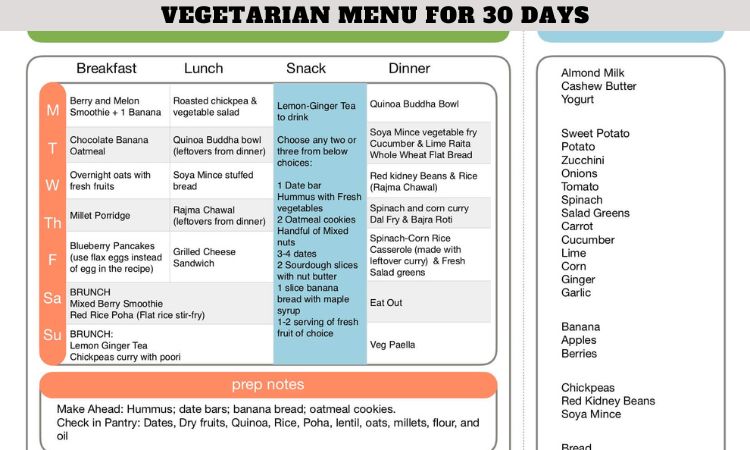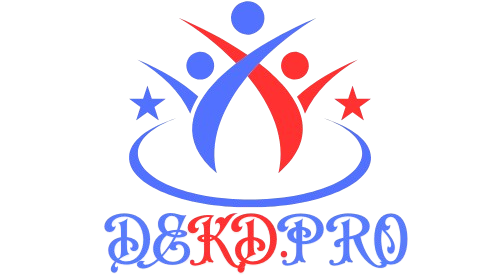Vegetarian Menu for 30 Days
Vegetarian Menu for 30 Days

A well-planned vegetarian diet offers numerous health benefits, ranging from improved digestion to a reduced risk of chronic illnesses. If you are embarking on a journey to embrace vegetarianism, crafting a vegetarian menu for 30 days can help you stay organized, meet your nutritional needs, and keep your meals exciting. In this guide, we provide a detailed and balanced meal plan that will make your 30-day vegetarian journey enjoyable and fulfilling.
Why Choose a 30-Day Vegetarian Menu?
A structured vegetarian menu for 30 days is not just a diet—it’s a sustainable lifestyle choice. It allows you to:
- Explore diverse cuisines while incorporating more fruits, vegetables, legumes, and grains into your meals.
- Boost your energy levels with nutrient-dense, plant-based foods.
- Reduce your environmental impact by consuming fewer animal products.
- Discover the health benefits, such as weight management and improved heart health.
Key Components of a 30-Day Vegetarian Menu
Before diving into the meal plan, it’s essential to understand the building blocks of a healthy vegetarian diet:
1. Protein Sources
Plant-based protein can be found in:
- Lentils, chickpeas, and beans
- Tofu, tempeh, and edamame
- Nuts, seeds, and nut butters
- Dairy products like cheese and yogurt (for lacto-vegetarians)
2. Whole Grains
Grains provide essential carbohydrates and fiber, including:
- Quinoa, brown rice, and whole-wheat pasta
- Oats, barley, and farro
3. Fruits and Vegetables
A variety of fresh, seasonal produce ensures a wide spectrum of vitamins and minerals.
4. Healthy Fats
Incorporate avocados, olive oil, and flaxseeds for essential omega-3 fatty acids.
5. Essential Nutrients
Supplement with vitamin B12, iron, calcium, and zinc if needed to fill potential gaps in a plant-based diet.
30-Day Vegetarian Menu Plan
Week 1: Introducing Plant-Based Variety
Day 1:
- Breakfast: Overnight oats with almond milk, chia seeds, and fresh berries.
- Lunch: Spinach and chickpea salad with tahini dressing.
- Dinner: Grilled tofu with quinoa and steamed broccoli.
Day 2:
- Breakfast: Whole-grain toast with avocado and a sprinkle of sesame seeds.
- Lunch: Lentil soup with a side of whole-grain bread.
- Dinner: Vegetable stir-fry with soba noodles and a ginger-soy sauce.
Day 3:
- Breakfast: Smoothie bowl with bananas, spinach, almond butter, and granola.
- Lunch: Mediterranean-style stuffed bell peppers with couscous and olives.
- Dinner: Eggplant parmesan served with a side of mixed greens.
Day 4:
- Breakfast: Greek yogurt with walnuts and honey.
- Lunch: Black bean burrito with guacamole and salsa.
- Dinner: Sweet potato curry with brown rice.
Day 5:
- Breakfast: Scrambled tofu with sautéed spinach and whole-grain toast.
- Lunch: Quinoa salad with roasted vegetables and lemon vinaigrette.
- Dinner: Mushroom risotto with a side of roasted asparagus.
Day 6:
- Breakfast: Vegan pancakes topped with maple syrup and fresh fruit.
- Lunch: Hummus and veggie wrap.
- Dinner: Vegetarian chili with cornbread.
Day 7:
- Breakfast: Chia pudding with almond milk and mango.
- Lunch: Spinach and feta flatbread.
- Dinner: Grilled vegetable kebabs with a side of couscous.
Week 2: Expanding Your Culinary Horizons
Explore international vegetarian dishes in Week 2, incorporating cuisines from around the world.
Day 8: Thai green curry with tofu and jasmine rice.
Day 9: Italian caprese salad with balsamic glaze and crusty bread.
Day 10: Middle Eastern falafel wrap with tahini sauce.
Day 11: Indian chana masala with naan bread.
Day 12: Japanese miso soup with soba noodles and seaweed salad.
Day 13: Mexican enchiladas stuffed with black beans and cheese.
Day 14: Moroccan vegetable tagine with couscous.
Week 3: Creative Vegetarian Recipes
In Week 3, add variety with unique, nutrient-dense meals.
Day 15: Zucchini noodles with pesto and cherry tomatoes.
Day 16: Veggie burger on a whole-grain bun with sweet potato fries.
Day 17: Cauliflower fried rice with tofu and sesame seeds.
Day 18: Baked eggplant rolls stuffed with ricotta and spinach.
Day 19: Tempeh tacos with avocado crema.
Day 20: Butternut squash soup with a side of garlic bread.
Day 21: Vegan sushi rolls with avocado, cucumber, and carrot.
Week 4: Balanced and Sustainable Eating
Week 4 emphasizes balance and simplicity for long-term sustainability.
Day 22: Buddha bowl with quinoa, roasted veggies, and tahini drizzle.
Day 23: Stuffed zucchini boats with lentils and marinara sauce.
Day 24: Peanut noodles with stir-fried vegetables.
Day 25: Polenta topped with sautéed mushrooms and spinach.
Day 26: Veggie lasagna layered with zucchini, spinach, and ricotta.
Day 27: Black bean and corn salad with lime vinaigrette.
Day 28: Roasted cauliflower steaks with chimichurri sauce.
Day 29: Spinach and ricotta ravioli with tomato basil sauce.
Day 30: Grilled cheese sandwich with tomato soup.
Tips for Success with a 30-Day Vegetarian Menu
- Meal Prep: Dedicate a day to batch-cooking grains, legumes, and roasted vegetables.
- Stay Hydrated: Drink plenty of water and herbal teas.
- Stock Up on Essentials: Keep your pantry filled with staples like canned beans, whole grains, and spices.
- Experiment: Use this month to try new recipes and cooking methods.
Frequently Asked Questions (FAQs)
1. What is a 30-day vegetarian menu?
Ans. A 30-day vegetarian menu is a pre-planned set of meals that include only plant-based ingredients and dairy products (if lacto-vegetarian) or eggs (if ovo-vegetarian). It aims to provide balanced nutrition while eliminating meat, poultry, and seafood from your diet for 30 days.
2. Can a 30-day vegetarian menu provide all the necessary nutrients?
Ans. Yes, a well-balanced vegetarian menu that includes fruits, vegetables, whole grains, legumes, nuts, and seeds can provide most essential nutrients. However, supplements for vitamin B12, iron, or omega-3s may be necessary for some individuals.
3. Is a vegetarian diet suitable for weight loss?
Ans. Yes, a vegetarian diet can support weight loss, as it often includes high-fiber, nutrient-dense foods that keep you feeling full longer. Portion control and mindful eating are key.
4. Can I follow a vegetarian menu if I have food allergies?
Ans. Absolutely! A vegetarian menu can be adapted to accommodate allergies by substituting ingredients like nuts, soy, or gluten with suitable alternatives like seeds, coconut products, or gluten-free grains.
5. How can I ensure I get enough protein on a vegetarian diet?
Ans. Plant-based protein sources include lentils, chickpeas, black beans, tofu, tempeh, edamame, quinoa, nuts, seeds, and dairy products (if applicable). Including a variety of these foods ensures adequate protein intake.
6. Is it expensive to follow a vegetarian menu?
Ans. Not necessarily. Staples like beans, lentils, rice, oats, and seasonal vegetables are often budget-friendly. Planning meals ahead and buying in bulk can further reduce costs.
7. Can children follow a vegetarian diet safely?
Ans. Yes, children can follow a vegetarian diet as long as it is well-balanced and includes sufficient protein, healthy fats, and essential vitamins and minerals. Consulting a pediatrician or nutritionist can help ensure they meet their dietary needs.
8. What should I do if I crave meat during the 30 days?
Ans. Cravings are normal, especially when transitioning to a vegetarian diet. Satisfy your craving with plant-based meat alternatives or hearty dishes like mushroom-based meals or lentil burgers, which offer similar textures and flavors.
9. Can I eat out while following a 30-day vegetarian menu?
Ans. Yes, many restaurants offer vegetarian options. When dining out, look for dishes marked vegetarian or customize meals by requesting the exclusion of meat or seafood.
10. What happens after the 30-day vegetarian menu?
Ans. After completing the 30 days, you can choose to continue with a vegetarian diet, transition to a plant-based or flexitarian lifestyle, or reintroduce animal products in moderation. Evaluate how the diet made you feel and decide what works best for you.
